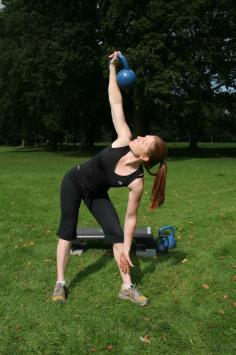One of my favorite kettlebell exercises is the KB windmill. I’m sure if Brett Jones is reading this he’s getting a laugh out of it. Here’s the 1-minute story.
I wrote an article for Dragon Door a while back about how powerlifters can benefit from using kettlebells in their programming. I put a picture of myself in there performing a windmill, and Brett subtly let me know that my technique was off. It wasn’t so much on purpose – I had been taught in correctly, but it was funny nonetheless.
I like the windmill for several reasons. First and foremost, it’s a great assessment tool. Obviously you won’t load this up on the first session with a client, but you can learn a lot of things about how your client moves from watching them attempt this exercise.
Do they move through their hips or lumbar spine?
What flexibility limitations do they have? I.e., where do they feel the stretch?
The windmill takes a ton of hip mobility. Often you’ll see people fail to “push into” their hip, and as such, they simply use a mix of lumbar flexion and rotation to produce the movement.
THIS IS HORRIBLE! Please don’t let your clients (or yourself) do this.
If you can’t go through a full range of motion initially, that’s fine. Work through your functional range, and as your mobility improves, work to slowly increase range of motion.
You can also get an idea of whether people want to load their hips as well. It’s not just a mobility thing; people with weak hips generally don’t want to push into and load their hips on this exercise. Again, work through their functional range to start, and look for asymetries between sides.
Here are a few cues/tips that made a big difference for me:
- Turn both toes to 45 degrees.
- The leg on the side your holding the kettlebell should be kept straight. This was a big issue for me before, as I was originally taught to bend this knee!
- Lock your torso/lumbar spine into a neutral position.
- Push into the hip, and think about lifting it up as well.
- If you start to lose your back position, immediately stop and return to the starting position.
When used correctly, this exercise falls right in line with the joint-by-joint approach – mobility in the t-spine and hips, stability in the lumbar spine.
The unfortunate thing is many people (myself included) have butchered the exercise at one point or another. Take the time to perform it correctly and I think you’ll love the kettlebell windmill as well!
Stay strong
MR

